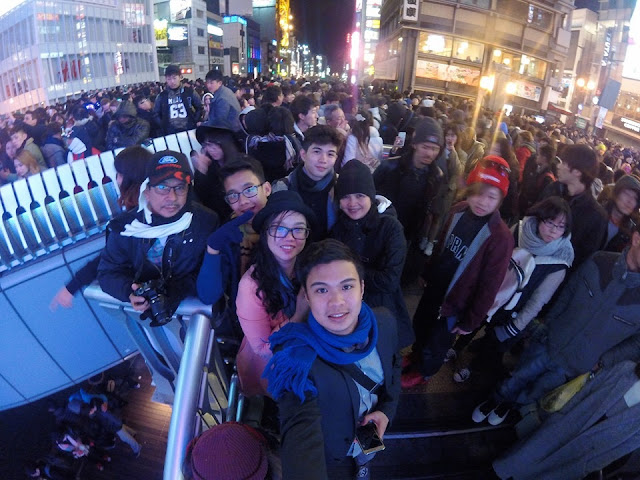 |
| Mandatory Airport Picture before boarding |
Since I was a kid, my mom
has always wanted to spend New Year’s Eve in a place other than Manila. As many
of you know by the now, New Year’s Eve in Manila is very loud and dangerous
most especially it is common in this country to welcome the New Year by firing
guns, thus the increasing number of victims of the ligaw na bala.
However, it was only last
year that we had the chance to go out of town on New Year’s Eve. We welcomed
2015 in Puerto Princesa. This year, we flew all the way to Osaka.
I was in charge of preparing
the itinerary for this trip. I took into consideration the fact that we would
be landing in Osaka around 730PM on New Year’s Eve. I was determined to find
out how the Japanese welcome the New Year. I soon discovered that the Japanese
do not celebrate New Year’s Eve in the same manner as Filipinos do. In fact, in
Japan-Guide.com, it was stated that Traditional Activities on New Year’s Eve
include watching the popular music program “kohaku uta gassen,” on television
and visiting a shrine or temple around midnight. In recent decades, countdown
parties have become more numerous in the large cities, but fireworks at the
turn of the year remain uncommon. Hence, we planned on welcoming the New Year
in Dotonbori, the Gastronomical Capital of Japan.
We left Manila at 230PM, 31
December 2015. Four hours later, we arrived in Kansai Airport in Japan. Upon
arrival, it became very apparent that New Year’s Eve in Osaka would be a far
cry from what I have experienced in the Philippines. There were no fireworks
that light up the sky.
 |
| On board PR 408 bound for Osaka |
 |
| Touchdown, Osaka |
From the Arrival Hall, we
headed straight to the Train Station. As we will stay in an Air BNB in Namba
(see Here), we took the Nankai Line. It is highly recommended that those
visiting Osaka stay in Namba. Namba is known as an entertainment district and
the main terminus for the south central railway terminals: the JR Line,
Kintetsu, Nankai, Hanshin and three lines of the Osaka Subway. You can pretty
much go anywhere you want from Namba through the trains (I’ll show this in the
later parts of this series).
 |
| At the Train Station |
 |
| Kansai Airport Station |
From Kansai Airport, we took
the Limited Rapi:t Express. One ticket to Namba costs 1,130 JPY (Regular Seat).
The station and the trains
are very modern. I was amazed by the fact that their train stations are more
beautiful than our airports in the Philippines. While the Japanese are not very
fluent in English, it is not difficult to understand the train system. The
train that brought us to Namba had restrooms, decent wifi connection and a
place where the passengers can stow their baggage. The Limited Rapi:t Express
is undeniably the most convenient way to travel to and from the airport.
 |
| Hello from Me and my Dad |
The train ride from Kansai
Airport to Namba lasted for about forty minutes. Our Airbnb host said that her
place is within walking distance from the Namba Station. Unfortunately, since
we were not very familiar with the streets, we rode a cab to the place. I was a
bit worried that the cab driver wouldn’t understand us. Thankfully, he was able
to understand the map given to us by our home and was able to find the
apartment through the use of his GPS.
I admire the politeness and
friendliness of the cab drivers. At first, our cab driver made a wrong turn
which made it more difficult to find the Apartment. But despite the mistake, he
turned the meter off and made efforts to make sure that we reach our
destination. (By the way, the politeness and friendliness of the people in
Japan is one of the many things I love in this country. While they are not very
fluent in English, they would help you out in every way they can). What I love most is the fact that he turned off the meter when we reached the destination that he entered in his GPS. He did not charge us even if we made a few more turns to reach the apartment. This is definitely a far cry from how cab drivers in the Philippines behave!
After having light snacks in
the apartment, my family decided to go to Dotonbori to explore the place and
participate in any New Year’s Eve party, if any. As we are unsure if there are
still any restaurants open, we stopped by a Ramen place near our apartment. We
had a bowl of authentic Ramen with tempura on the side.
 |
| The Ramen Place near our Apartment |
 |
| Two of my favorites: Ramen and Tempura |
Having finished our sumptuous
meal, we headed straight to Dotonbori.
 |
| The Streets of Namba, Half an Hour before New Year |
 |
| Walking along Dotonbori |
We noticed people in costumes as we walked from Namba Station to the Dotonbori River. There was also a large group of people gathered ‘round the Dotonbori River. Apparently, a group of teenagers will dive into the river when the clock strikes twelve despite the huge sign that prohibits diving and the fact that a teenager died in said activity a year ago.
 |
| People waiting for the New Year |
Groups of young men began to arrive, all determined to dive into the river. Thus, it has gotten a bit rowdy about five minutes to midnight which made us decide to leave the area.
 |
| A young man dives into the river |
We were in the middle of the
street when the clock struck twelve. We greeted each other a Happy New Year and
continued to watch the festivities from afar. Five minutes after, the people
began to disperse and we too made our way back to the Apartment.
 |














0 comments